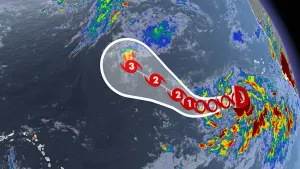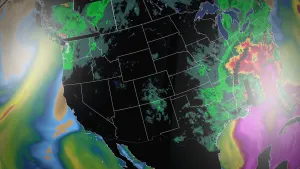
After centuries lying dormant, this Alaska volcano is showing signs of life
After centuries of inactivity, a volcano in the Alaskan panhandle has awakened from dormancy.
Scientists have traced a swarm of minor earthquakes around Sitka, Alaska, in 2020 to magma activity below Mount Edgecumbe (L'úx Shaa), around 450 kilometres northwest of Prince Rupert, B.C.
Through computer modelling with satellite radar, scientists at the Alaska Volcano Observatory were able to pinpoint in April that the many small quakes were being caused by rising magma levels below the 976 metre-high peak at the southern end of remote Kruzof Island.
Despite the activity, scientists say an eruption is very unlikely, and no emergency protocols need to be put in place.

Mount Edgecumbe pictured on May 19. Scientists traced seismic activity in the Alaskan panhandle to rising magma beneath the mountain, which has not erupted for centuries. (Max Kaufman/Alaska Volcano Observatory)
Magma causing ground to lift
According to the observatory's findings released last month, the volcanic activity has been brewing since 2018 but remained undetected for several years due to minimal monitoring in the area.
Magma levels have risen by about 10 kilometres from a depth of 20 kilometres since around late 2014, said Ronni Grapenthin, associate professor of geodesy at the University of Alaska and lead author of the study.
The study says the rising magma pools have also caused deformations in the ground around the volcano — the most striking of which is centred just east of the mountain, where an area of around 17 kilometres in diameter has lifted nearly 27 centimetres in less than four years.
Grapenthin likened the rising magma to an inflating balloon.
"If you have magma that is moving to a shallower depth, it's moving into a space and adds pressure, then the surface on top of that would kind of gently move upwards," he said.
No imminent eruption
Mount Edgecumbe last erupted explosively about 4,000-5,000 years ago, according to Grapenthin. Oral histories from the Klingit Nation in Alaska also cite smaller explosive activity around 900 years ago.
Grapenthin says Edgecumbe is not going to erupt anytime soon.
"The magma is just going to continue to pool where it is and sit there happily. We see that happening a lot around volcanoes. Magma more often just moves to shallower depth and then doesn't erupt," he said.

The City of Prince Rupert said its emergency personnel had been made aware of the regional volcanic activity and has reviewed its emergency plans.
"At this point, there has been no local alert or hazard watch issued for our area," it said in a statement to CBC News.
Melanie Kelman, a volcanologist with the Geological Survey of Canada who monitors volcanic hazards, also says an eruption is unlikely.
"It is in an area where there's air traffic above, so obviously, it's a concern for the aviation community if it were to erupt," said Kelman.
"Right now, it's really a sign of showing the speed of magmatic unrest. Often this kind of unrest is not followed by an eruption."
Ongoing monitoring
However, Grapenthin says the risk of an eruption could increase if too much magma moves into the area where it pools, increasing pressure and causing the rock to break.
He also says a large earthquake would increase the probability.
"That would literally shake the magma like you would shake a soda, and that would rapidly increase those pressures," he said.
Grapenthin says the observatory is still trying to determine what caused the resurgence of volcanic activity. Researchers have installed on-the-ground instrumentation to monitor seismic activity in the area.
Alongside monitoring earthquakes in the area, scientists at the observatory are looking into whether the deformation patterns are changing and if there are any gasses being brought to the surface.
This article, written by Ali Pitargue, was originally published for CBC News.









